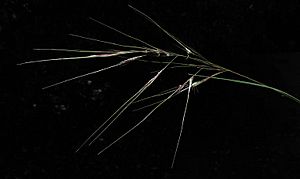Nassella cernua facts for kids
Quick facts for kids Nassella cernua |
|
|---|---|
 |
|
| Conservation status | |
| Scientific classification | |
| Genus: |
Nassella
|
| Species: |
cernua
|
| Synonyms | |
|
Stipa cernua (former) |
|
The Nassella cernua, also known as nodding needlegrass, is a type of grass. It was once called Stipa cernua. This grass grows in bunches, which means it forms a clump instead of spreading out.
Nodding needlegrass is native to (meaning it naturally grows in) western California in the United States. It also grows in Baja California in Mexico.
Where Nodding Needlegrass Grows
Nassella cernua is an important part of the natural plant communities in California and Baja California. You can find it in native grasslands, chaparral (a type of shrubland), and juniper woodlands. This bunchgrass lives in mountain ranges like the California Coast Ranges and Transverse Ranges in the U.S. It is also found in the Peninsular Ranges, which stretch into both the U.S. and Mexico.
Many native grasses, including nodding needlegrass, have faced problems. They have declined because of introduced species of grasses. These are grasses brought in from other parts of the world. They often grow very fast and take over the space where native grasses used to thrive. This makes native grasslands a very endangered habitat. Because of this, nodding needlegrass is considered a vulnerable species.
What Nodding Needlegrass Looks Like
Nodding needlegrass is a perennial plant. This means it lives for more than two years. Its stems can grow quite tall, reaching about 2 to 3 feet (0.6 to 0.9 meters) high. The leaves of this grass are narrow and have a slightly waxy feel.
The plant's flowers grow in a loose, open cluster called a panicle. The branches of this cluster often bend or "nod," which is how the grass gets its common name. Each tiny flower has a long, bristle-like part called an awn. This awn can be up to 4 inches (10 centimeters) long.
How People Use This Grass
Nassella cernua is grown by special plant nurseries. People use it as an ornamental grass in gardens. It is popular because it is drought-tolerant. This means it does not need much water to grow well.
It is often used in native plant gardens, which focus on plants that naturally grow in an area. It is also good for wildlife gardens, as it can provide food or shelter for local animals. For people who want to save water, nodding needlegrass is perfect for xeriscaping. This is a type of landscaping that uses plants needing very little water. The grass is also used in habitat restoration projects. These projects aim to bring back natural environments that have been damaged.


